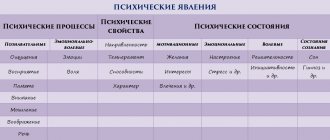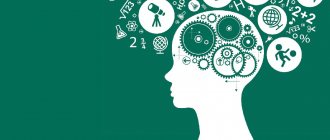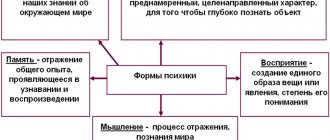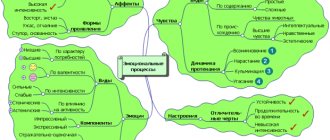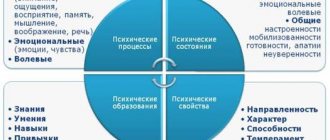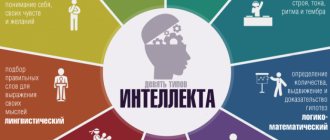Mental processes are a conditional division of the psyche into component elements that allow us to cognize the external and internal world. This is such a complex phenomenon and so little is known about it that there are quite a few definitions and interpretations of this phenomenon.
The development of mental processes occurs in specific conditions of interaction with the outside world: the special properties of our planet, the transition from winter to summer, changes in gravity and much more - put forward certain requirements for a person. Therefore, the psyche acts as a regulator of the body’s behavior.
The functions of mental processes depend entirely on the species. All mental processes can be divided into three types:
Cognitive:
- perception;
- memory;
- thinking;
- sensation;
- imagination;
- performance;
- speech;
- attention.
Emotional:
- feelings;
- emotions;
- stress;
- affects.
Strong-willed:
- will;
- goal setting;
- decision-making.
There is also an inseparable interconnection of mental processes, which is expressed, for example, in the fact that memory is impossible without attention, perception is impossible without memory, and so on. Therefore, if you want to improve the functioning of your mental processes, it will be enough to develop several of them. For example, memory, imagination, emotions and will. However, your list may be completely different. In any case, it should not surprise you that by developing your attention, all other processes immediately “catch up”.
Study methods
In the field of psychiatry and cognitive science, the following methods are used to study the processes of memory, perception, thinking, attention and other functions:
- Recognizing figures by touch and manipulating them tactilely (Seguin board).
- Visual recognition of real, noisy, contour and defocused images (Poppelreiter test).
- Perception of objects requiring visual-spatial processing (contour geographical map, schematic clock).
- Recognizing familiar portraits of famous people.
- Listening perception and assessment of rhythmic structures.
- Detection of memory impairments (Pictogram technique).
It should be said that it is possible to identify a violation of the mental process only with the help of several methods, that is, problems need to be diagnosed in a complex manner.
The largest number of techniques explore thinking. The most famous is “Classification of Objects”, where it is possible to study various aspects of the thinking process. Also known: understanding the figurative meaning of metaphors and proverbs, solving arithmetic problems of varying degrees of complexity, comparing and defining concepts.
Now let's talk separately about the course of mental processes and states, their characteristics, properties and functions.
Issues
Due to mental disorders, development is inhibited, problems arise with perception and assimilation of new information. Perception disorders:
- false recognitions;
- deception of feelings;
- distortion of perceived objects.
Thinking disorders:
- revaluation of ideas;
- delirium;
- obsessive thoughts.
Memory impairments:
- cryptomnesia;
- confabulation;
- echonesia.
Emotional disorders:
- hyperthymia;
- euphoria;
- depression;
- obsessive emotions;
- confusion.
Mental cognitive processes
Let's consider each process separately.
1
Perception
Perception is a holistic reflection of objects and phenomena in the totality of their properties and parts with their direct impact on the senses. It occurs in close relationship with other mental processes: first of all, with sensations that, with the help of sensors, collect information from the outside world, and secondly, with memory, will and attention. Perception is the interpretation of what our sensors have collected.
Perceptual properties include:
- Structurality: an object is perceived by consciousness as a simulated structure abstracted from sensations.
- Objectivity: objects are perceived not as an incoherent set of sensations, but as images that make up specific objects.
- Constancy: constancy of perception of the same object.
- Apperception: perception is influenced by the general content of the human psyche.
- Selectivity: preferential selection of some objects over others (perception here works closely with attention).
2
Memory
Memory is a complex of cognitive abilities for the accumulation, preservation and reproduction of knowledge and skills. Memory is closely related to thinking, perception and sensations.
The main function of memory is to store information, which a person can then use for certain purposes. Without it, we would not have an identity.
The properties of memory include: volume, accuracy, speed of memorization and forgetting processes.
There are different typologies of memory:
- By content: spatial, social, emotional, eidetic, sensory, verbal-logical, figurative.
- By sensory modality: motor, visual, gustatory, auditory, olfactory, eidetic, pain.
- By storage time: long-term, short-term, ultra-short-term.
- According to the organization of memorization: declarative and procedural.
- According to the presence of a goal: voluntary and involuntary.
3
Thinking
Thinking is the process of modeling the patterns of the surrounding world, the highest stage of human information processing. We can say that this is the final mental process that guides the personality.
With the help of thinking, a person can completely change his perception, imagination, attention, will and even sensations. The highest degree of human knowledge.
Basic characteristics of thinking:
- Indirect cognition of objective reality: even on the basis of indirect information we can judge the properties of objects and phenomena.
- Generalization of the reflection of reality: the transition from individual objects to the general.
4
Feel
Sensation is a mental reflection of individual properties and states of the external environment, subjects of external or internal stimuli with the participation of the nervous system.
Canonically, there are five types of sensations: smell, taste, touch, vision, hearing.
Properties of sensations:
- Intensity: a quantitative characteristic of sensations.
- Modality: qualitative description of sensations.
- Duration: temporary characteristic of sensations.
- Localization: spatial characteristics of sensations, information about the location of the stimulus in space.
5
Imagination
Imagination is a person’s ability to create images, ideas and ideas in the mind, as well as to manipulate them. The functions of imagination are to imagine in the head a sample of the future result of an activity in planning, searching for a strategy for solving problems.
Properties of imagination:
- Dream: an emotional image of a desired future that is characterized by little knowledge of how to make it a reality.
- Creativity: creation of new spiritual and material values.
- Agglutination: the creation of new images based on “gluing together” parts of existing images.
- Hallucination: unreal images that a person experiences during illness.
- Emphasis: creating new images by highlighting and emphasizing certain features.
6
Performance
A representation is an image of a phenomenon or object that a person does not perceive here and now. It differs from imagination in that a person is simply trying to remember the image, and not come up with something new.
The functions of representation depend on the type of human activity: artists need to remember the desired image, musicians need to remember the desired melody or sound. Imagination helps to solve complex and imaginative problems, including creative ones.
View properties:
- Fragmentation. The more attractive an object was to a person, the more detail he can imagine it.
- Visibility. A person represents the image of a perceived object exclusively in visual form.
- Generality. The image of an object has a certain information capacity.
- Instability. The image can only be held for a certain amount of time.
7
Speech
Speech is a form of communication between people through linguistic structures. Inherently connected with thinking and presentation.
It helps convey important information to us, as well as convey socio-historical experience.
Properties of speech:
- Clarity. Syntactically correct construction of sentences, the ability to correctly pause or place logical emphasis on the right word.
- Content. The percentage of valuable words expressed in relation to those that are not valuable (the so-called “water”).
- Effectiveness. The influence of speech on the thoughts, will and feelings of other people.
- Expressiveness. Emotional richness, richness and variety of linguistic means.
8
Attention
Attention is the selective focus of perception on a particular object. It is very closely related to memory (some cognitive scientists believe that this is one and the same thing), as well as will.
With the help of will, a person can change his attitude towards an object and pay conscious attention to it, that is, highlight it from the rest. Attention helps a person to successfully navigate the world around him.
By the properties of attention one should mean: volume, direction, concentration, distribution, intensity, switchability and stability.
Kinesthetic (motor) sensations – sensations of movement and position of body parts
Do a little experiment. Close your eyes and stand in some position: follow the command “at attention”, and then take the same position again. Think about which of the five senses helped you repeat the movement? It was moving 12
a painful sensation
caused
by irritation of receptors located in muscles, ligaments, and joints.
When walking, dancing, cycling, we feel a change in the speed or direction of our movement thanks to the vestibular apparatus of the inner ear.
Vibration sensations - occur when the surface of the body is exposed to air vibrations produced by moving or oscillating bodies
They play an important role in the deaf and blind. With the help of these sensations, deaf-blind people learn about the approach of a vehicle or a person, touching the lips of a speaking person and feeling their vibration, they can learn the alphabet and then speak.
are distinguished separately .
There is evidence that a person, with the help of ordinary senses, can perceive stimuli that are beyond the lower threshold of his sensitivity, that is, a person reacts not only to those signals that he is aware of, but also to those that he is not aware of. Premonition and foresight are built on this.
Abram Pshonik conducted an experiment with his daughter in 1952. In the kitchen during breakfast, the daughter kept her finger on the button to which the current was connected. When the light came on, the current flowed, you had to have time to take your finger off the button. Over time, the girl, without the light bulb, withdrew her finger, reacting to subthreshold sensations. Together with the light bulb, Pshonik turned on a generator of high-frequency sounds that were not audible to the ear, the girl reacted to these sounds.
Mental emotional processes
Let's consider each process separately.
1
Feelings
Feeling is a human emotional process that reflects a subjective evaluative attitude towards abstract or real objects. Feelings manifest differently among people because they are influenced by their own set of individual traits and personality traits. Necessary for communication, friendship and understanding of other people.
Properties of feelings:
- Content: reflection of various aspects, features of the meaning of the objects that cause them.
- Sthenicity: sthenic feelings mobilize a person’s strength, encourage him to active activity (hate, love). Asthenic paralyzes and relaxes (contempt and fear).
- Intensity: strength of feeling.
- Valence: pleasant, unpleasant and ambivalent feelings.
2
Emotions
Emotions reflect a subjective evaluative attitude towards objects, phenomena, situations and people. With the help of will, a person can evoke any emotion that he deems necessary.
The properties of emotions completely coincide with the properties of feelings.
3
Stress
Stress is a set of adaptive reactions of the psyche to stressors.
There is positive (eustress) and negative (distress) stress. The difference is in intensity: the more of it in the psyche, the worse.
4
Affects
Affects are emotional processes of an explosive nature. In many cases they are considered a negative manifestation of the psyche, but in a threatening situation they can save lives.
Emotions and feelings
Characteristics of mental processes allow you to thoroughly study and understand your own abilities and skills. However, an emotional phenomenon is something abstract and defies logic. The classification of emotional mental processes has only three points.
1. Emotions. This is an excited state that can convey some feelings through gestures, facial expressions and speech. It originates within through specific memories or sensations.
Emotional mental processes are difficult to explain by science, because most often they are expressed unconsciously. This is what worries a person inside, but breaks out. Emotions can show joy, anger, hostility and many other feelings.
We recommend: The science of gestures - pantomime
2. Feelings. Sometimes feelings are unconscious mental processes that are a sincere experience of a situation. They are difficult to fake, because they are considered part of the soul.
By the way, they are external and internal. The former show, for example, a reaction to weather conditions or someone’s touch, while the latter reflect specific moods and emotional impulses. By the way, sometimes feelings are confused with sensations, but these are completely different things.
3. Affect. A vivid and usually very memorable experience that quickly appears and passes just as unexpectedly. Usually this state is influenced by non-standard events that take a person by surprise. In such a state of mind, a person can commit rash acts, which he will later regret.
These types of mental processes are considered very intense for the psyche. Typically, a state of affect forces an individual to make a single choice that may be unusual for him. Most often, such activity manifests itself in aggression.
Mental volitional processes
Let's consider each process separately.
1
Setting a goal
Goal setting is the process of selecting one or more goals. Closely related to willpower and emotions.
2
Will
Will is the ability of a person to make a decision based on the thought process and direct his actions and thoughts in accordance with the decision made.
As follows from the definition, will is closely related to thinking and decision-making. But, besides this, without it conscious attention and developed memory are impossible.
3
Making decisions
Decision making is a mental process that is characterized by the use of willpower to set a goal and a firm intention to achieve it.
Will
These mental processes are independent, they take on certain properties and states, but the choice is made consciously. In this case, the individual himself controls his feelings and behavior, making choices that he does not always like, but which will be useful for him or society.
The classification of volitional mental processes includes the following types:
1. The struggle of motives. This is the absence of one specific choice that would suit a person. This condition is also called intrapersonal conflict. It means the presence of absolutely equal solutions for some situation that requires a single answer.
Specifically, conscious preference can be attributed to the volitional process, since the logically correct or moral alternative is a child of the mind. It is worth noting that this develops over the years, so children have very weak willpower.
We recommend: What is mental reflection in psychology?
2. Decision making. This process is about establishing some certainty. Moreover, sometimes the choice can be elementary (eat a cutlet or pilaf, wear a yellow or green T-shirt), and sometimes it can be very difficult. Although even in simple situations we often use willpower.
Making decisions quickly and consciously is a habit of successful people. In this case, not only reason, logic and meaning may be needed, but often the same emotions and feelings.
3. Goal setting. This is a clear awareness and determination by the individual of specific desires, the fulfillment of which he wants to achieve. This approach significantly advances the individual towards the realization of a dream, because setting a goal is a serious step.
For most people, this process generates a certain motivation, which is very important for achieving any goals. In addition, such decision-making involves a conscious choice, which has a strong impact on the psyche.
Development of mental processes
When they talk about the development of mental processes in children, the first thing they distinguish is their age group.
From 2 to 6 years of age, the child develops mental processes. Parents can influence this if they coach them. Here are exercises you can give your children:
- Place some toys on the table. The child must remember their location and presence. Then he closes his eyes and you remove or move one of them. He must say what has changed.
- When your child has mastered this exercise, make it more difficult. Remove 2 or 3 toys.
- The following game is suitable for developing thinking: place four pictures in front of the child, where three of them relate to a specific topic. The child must guess which one is extra.
- When going to the store, give your child a list of products (3-4 to start with) to memorize. In the store he must remember them (long-term memory is trained).
If your child is 7-8 years old, he should be able to:
- Find 10 differences between objects.
- Complete the task without distraction for about 15-20 minutes.
- Copy a movement or pattern exactly.
- Complete tasks independently according to the proposed sample.
- Be able to find identical objects.
- Be able to sequence events and compose a coherent story using pictures.
- Build a logical series from a specific group of objects.
- Repeat verbatim sentences consisting of 7-8 words.
The mental processes of an adult are formed at the age of 16. But this does not mean that they cannot be trained and improved. In fact, thinking can and even needs to be developed throughout life. Therefore, in conclusion of the article, we suggest that you take one of our courses (or all of them):
- Memory development
- Logical thinking.
- Emotional intellect.
- Cognitive science
Also, be sure to practice by solving problems from our “Games, Challenges and Entertainment” section.
We wish you good luck!
We also recommend reading:
- Storytelling
- Exercises for memory development in preschoolers
- Two important laws of memory
- Sensations: what they are and what they are like
- Cognitive processes
- Cognitive psychology and cognitive psychotherapy
- Spheres of personality
- Intelligence and its development: several recommendations
- Sensation and perception
- Cognitive sphere of personality
- Human attention: what it is and how it works
Key words:1Self-knowledge
Kinds
Scientists distinguish three types of psychological processes - cognitive, emotional, volitional. Each of these species has several subspecies.
Cognitive
With the help of cognitive processes, a person assimilates new information, develops skills, and gains experience. The individual collects new data, processes it, and stores it in memory.
Feeling
Sensation is a mental reflection of states and properties of the environment. In order for a person to receive information, he must be influenced by stimuli. Sense organs have receptors that are responsible for receiving and transmitting nerve impulses. Since the data received is not processed by the mind or culture, it is considered natural and truthful.
Perception
Perception is a mental process through which phenomena of the external world and images of objects are formed. When compared with sensations, perception can be called objective, holistic.
The formation of a general picture of an object or phenomenon is influenced by:
- mood;
- expectation;
- the power of desire;
- primary data about the subject;
- fantasies.
Therefore, the final result does not always meet expectations; it cannot be called completely independent.
Performance
Reflects phenomena and objects with which a person is not currently in contact. Images are created from past experience. Therefore, the result of ideas can be called secondary experience.
Imagination
Immersion of a person in the inner world. It creates ideas, pictures, images. With the help of imagination, you can see an image that you cannot touch in the real world. Imagination is associated with the development of memory and creative endeavors.
Thinking
Responsible for the ability to solve emergency problems. At the same time, ways to solve the current situation are selected that have not been used before. Another interpretation of the concept of “thinking” is an endless stream of different meanings, pictures, thoughts.
Memory
The innate ability to remember the necessary information in order to use it at the right time. One of the components of memory is forgetting. It is needed to quickly recall the necessary information. If a person did not know how to forget, he would have problems reproducing what is required at a certain moment.
Attention
Complex information selection system. With its help, a person perceives only the data that he needs. There are two types of attention:
involuntary - a person pays attention to bright colors, loud sounds, fast movements; arbitrary - the choice of the goal to which you need to pay attention is carried out independently.
Emotional
Emotions in psychology are processes that reflect the assessment, personal significance of internal and external situations that affect a person’s life.
Active
Active emotional mental processes include affect - a short-term, strong emotional experience, which is accompanied by visceral, motor manifestations. Affects begin to actively develop only in emergency situations, when a person cannot find a single option for adequate solutions.
They are dominant, suppress other mental processes, and impose stereotypical ways of solving the current situation.
Passive
Passive emotional mental processes include feelings. They differ from needs, moods, emotions. Feelings appear openly only in special moments, during strong experiences. More often they are hidden inside a person and do not appear.
Strong-willed
Conscious regulation of one's activities and behavior. They become more active in order to overcome external and internal barriers in order to achieve what is necessary and change themselves.
Solution
A decision is an act of will. With its help, a person brings certainty to the current situation and his further actions. Situations often occur when an individual cannot understand what the right thing to do is.
To start acting, he looks for any adequate solution options.
Execution
Execution - active actions. They begin when the individual received information about the situation, analyzed it, and came up with a way to solve the problem.
An effort
To increase the desire to do something, an individual must be motivated. Motivation depends on prevailing needs and desires.
Thinking
Thinking is the process of reflecting reality in its essential connections and relationships and the formation of new knowledge. Thinking is a complex and important cognitive process, as a result of which a thought is formed. Thinking is classified into the following types:
- Visually effective. It arises in practice when performing operations that require mental activity;
- Visual-figurative. It is based on ideas and images;
- Verbal-logical. It is based on abstract processes that operate with logic and concepts.
Attention
Attention is the selection of the necessary information and ensuring the selective nature of conscious activity. A person is able to select the most important and necessary things from the huge flow of information that surrounds him. At the same time, the amount of attention is allocated, i.e. the number of incoming signals from stimuli that predominate and remain in the center of consciousness. Attention is also characterized by stability - this is the time for which certain processes prevail in consciousness.

